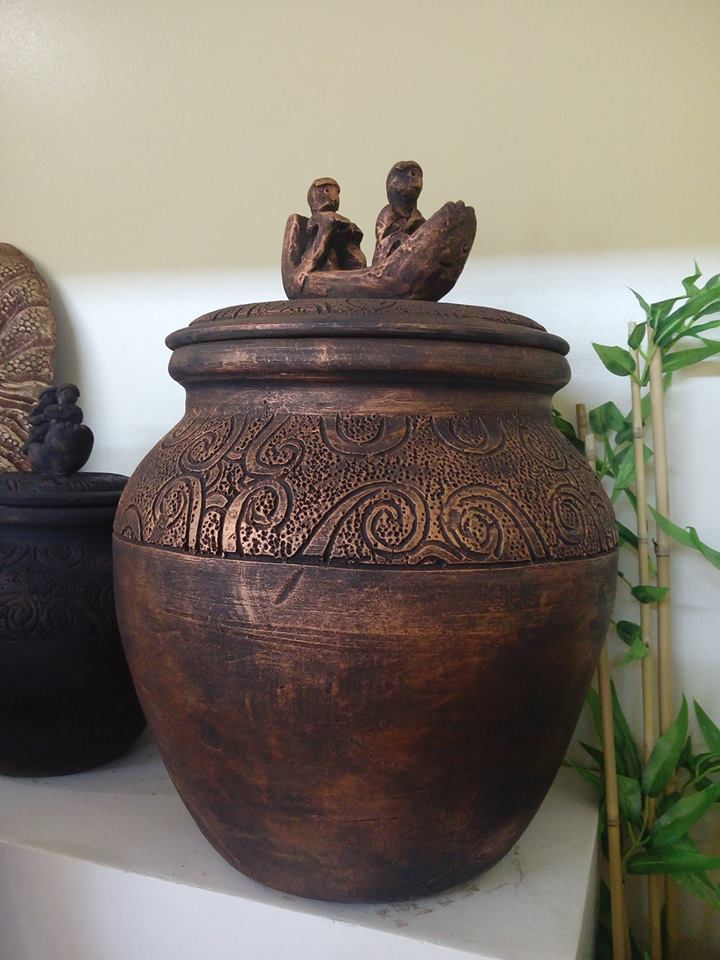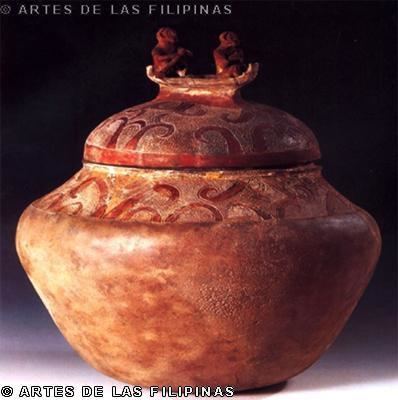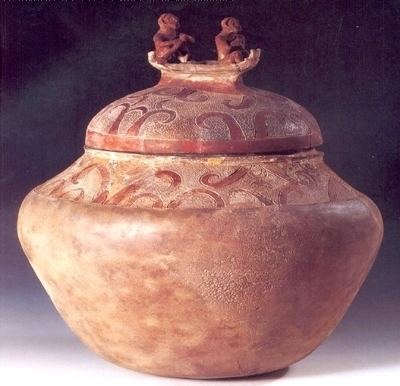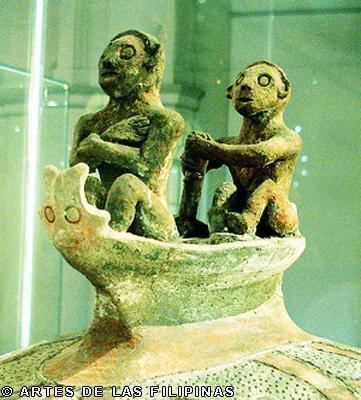Year 890-710 B.C. | Type Burial Jar | |
 | ||
Dimensions 66.5 cm (26.2 in); 51 cm diameter (20 in) Similar Spoliarium, The Parisian Life, Las Virgenes Cristiana, La Bulaqueña | ||
Manunggul jar
The Manunggul Jar is a secondary burial jar excavated from a Neolithic burial site in Manunggul cave of Tabon Caves at Lipuun Point at Palawan dating from 890–710 B.C. The two prominent figures at the top handle of its cover represent the journey of the soul to the afterlife.
Contents
- Manunggul jar
- Discovery of the Jar
- First Excavation and Response to Discovery
- Design of the Jar
- Jar burial
- References
The Manunggul Jar is widely acknowledged to be one of the finest Philippine pre-colonial artworks ever produced and is a considered a masterpiece. It is denoted a national treasure and it is designated as item 64-MO-74 by the National Museum of the Philippines. It is now housed at the National Museum of Anthropology and is one of the most popular exhibits there. It is made from clay with some sand soil.

Manunggul jar
Discovery of the Jar

The Manunggul Jar was found by Dr. Robert B. Fox and Miguel Antonio in 1962. It was found alongside the discovery of the remains of Tabon Man. It was recovered by Dr. Fox in Chamber A of Manunggul Cave in Southwestern Palawan. Manunggul Cave is one of the Tabon Caves in Lipuun Point. In the expansion, the Tabon Caves is known to be a site of jar burials with artefacts dating a range from 4250-2000 BP. Chamber A dates as a Late Neolithic burial site (890-710 BC). Seventy-eight jars and earthenwares, including the Manunggul Jar, was discovered on the subsurface and surface of Chamber A. Each artifact varied in design and form but was evidently types of funerary pottery.
First Excavation and Response to Discovery

As mentioned earlier, the first ever excavation that gave way to the discovery of this burial jar is on the year 1964 by Dr. Robert Fox. During that time, he and his team were excavating the Tabon Cave Complex, specifically in the Lipuun Point. In Fox’s excavation, it is yet the most unusual in all angles.
The inside of the jar contains human bones which are covered in red paint. Like the Egyptian burial practice, the jar was also found to be equipped with numerous bracelets.
“... is perhaps unrivaled in Southeast Asia, the work of an artist and a master potter.” — These words were said by Robert Fox when asked as to how he would describe the jar’s origin, based from its appearance.
Design of the Jar
The Manunggul Jar shows that the Filipinos' maritime culture is paramount that it reflected its ancestors' religious beliefs. Many epics around the Philippines would tell how souls go to the next life, aboard boats, pass through the rivers and seas. This belief is connected with the Austronesian belief of the anito. The fine lines and intricate designs of the Manunggul Jar reflect the artistry of early Filipinos. These designs are proof of the Filipinos' common heritage from the Austronesian-speaking ancestors despite the diversity of the cultures of the Filipinos. The upper part of the Manunggul jar, as well as the cover, is carved with curvilinear scroll designs which are painted with hematite. The depiction of sea-waves on the lid places this Manunggul jar in the Sa Huỳnh culture pottery tradition. These are people that migrated in an East to West migration from the Borneo-Palawan area to Southern Vietnam.
Early Filipinos believed that a man is composed of a body, a life force called ginhawa, and a kaluluwa. This explains why the design of the cover of the Manunggul Jar features three faces - the soul, the boatman, and the boat itself. The faces of the figures and on the prow of the boat have eyes and mouth rendered in the same style as other artifacts of Southeast Asia of that period. The two human figures in a boat represent a voyage to the afterlife. The boatman is holding a steering paddle while the one on his front shows hands crossed on his chest. The steersman's oar is missing its paddle, as is the mast in the center of the boat, against which the steersman would have braced his feet. The manner in which the hands of the front figure are folded across the chest is a widespread practice in the Philippines when arranging the corpse.
The Manunggul Jar's cover serves as a vivid illustration of the cultural connection between the archaeological past and the ethnographic present. It further symbolizes the ancient Filipinos' belief in an afterlife.
Jar burial
The practice of jar burial is an instance of secondary burial, in which only the bones of the deceased are reburied. The jar itself was not interred.
